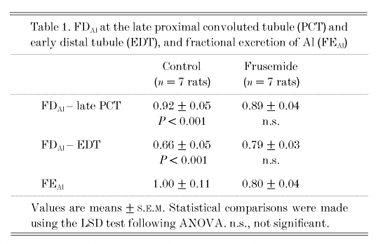In a previous investigation into the renal handling of aluminium (Al), we demonstrated significant Al reabsorption in the loop of Henle, and at high doses there was evidence for Al secretion further along the nephron (Shirley et al. 2001). In the present study we have assessed the effect of the loop diuretic frusemide on Al transport in the loop of Henle and beyond. Experiments accorded with UK legislation.
Male Munich-Wistar rats were anaesthetized with Intraval (May & Baker; 100 mg kg-1, I.P.) and prepared surgically for renal micropuncture. They were infused I.V. with 0.9 % NaCl solution containing [3H]inulin and aluminium chloride in 3 % sodium citrate solution (800 µg Al bolus, 20 µg Al min-1). In half the animals, frusemide (3 mg kg-1 h-1) was infused I.V., starting 1 h before micropuncture collections were begun; fluid balance was maintained by appropriate I.V. infusions. Timed collections were made from late proximal convoluted tubules and from early distal tubules (n = 2-3 collections per site per rat). Fractional delivery of Al (FDAl) to each puncture site was calculated from the tubular fluid/plasma concentration ratios for Al and inulin ([TF/PAl]/[TF/PIn]). At the end of each experiment, the rat was killed with an overdose of Intraval.
The results, shown in Table 1, confirmed that in control rats there was significant Al reabsorption between the two puncture sites; moreover, fractional excretion of Al (FEAl) exceeded early distal FDAl, suggesting Al secretion more distally. Frusemide treatment inhibited Al reabsorption in the loop and abolished Al secretion beyond the loop. We conclude that Al reabsorption in the loop of Henle is frusemide sensitive and we suggest that Al secretion in the distal nephron results from its diffusion into collecting ducts from the medullary interstitium; the latter process would be inhibited following disruption of the corticomedullary concentration gradient by frusemide.
This work was supported by the National Kidney Research Fund.

